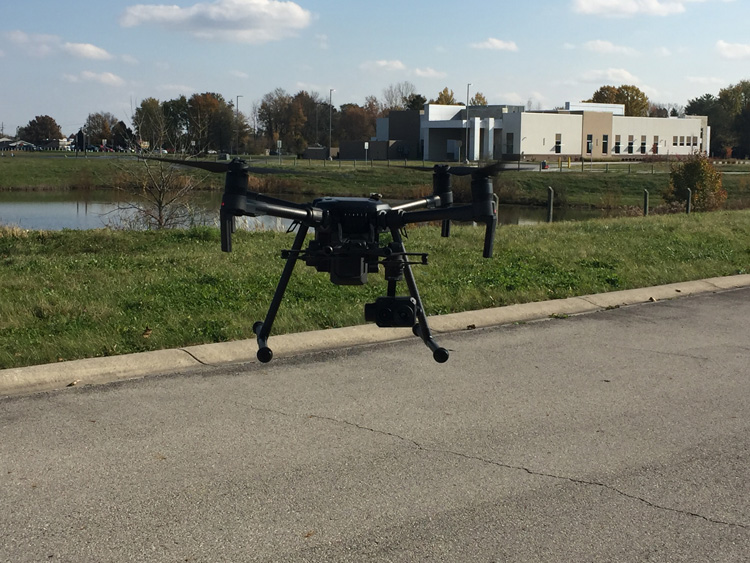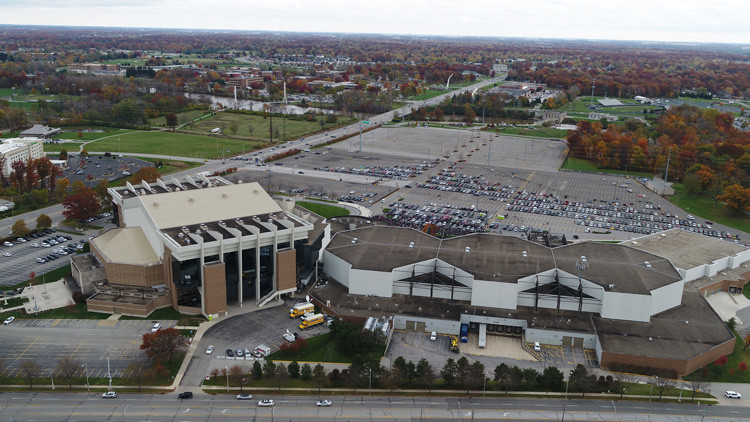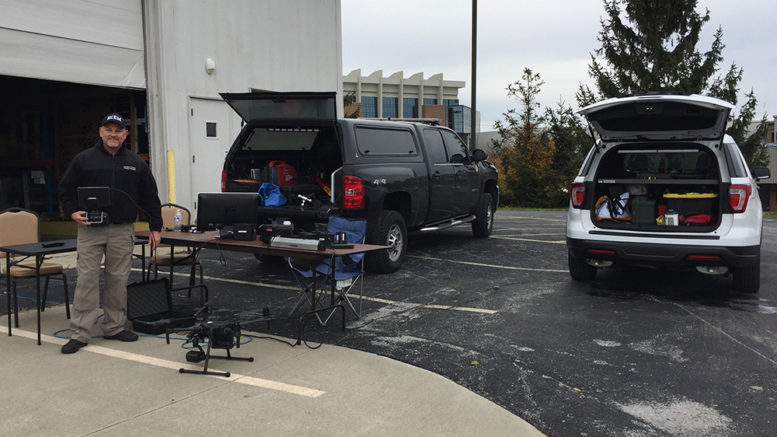Hamilton County EMA flies overwatch support for Secret Service
On Nov. 5, the President of the United States came to Indiana for a pre-election rally at the Allen County War Memorial Coliseum in Fort Wayne. Anyone looking to the skies that day may have seen Hamilton County unmanned aerial vehicles (UAVs) helping Fort Wayne Police, State Police and Secret Service in a unique interagency security detail.
The Reporter had the opportunity to speak with both EMA Coordinator and Hamilton County UAV Coordinator Steve Haston as well as EMA Executive Director Shane Booker about that opportunity and about county’s drone program in general. Both men were pilots at the event.
The opportunity arose when Fort Wayne Police Department UAV Director reached out to Hamilton County EMA about flying support for the President’s visit.
“Fort Wayne Police had come down to work with us when we were doing training in search and rescue,” Booker said. “They contacted us about this event because they do not have the same kind of aircraft we do. They asked if we would come up and fly. When the advance team from Secret Service met with Fort Wayne Police, their air support unit lieutenant met with the advance team explained the availability of drones able to stream live video.”

One of the DJI Matrice 210 drones Hamilton County EMA used to assist Secret Service with security hovers a few feet about the ground to pose for the Reporter’s camera. (Photo provided)
After the logistics and approvals were handled, Booker, Haston and the rest of their team headed to Fort Wayne for an opportunity that was at least unique to Indiana, and possibly to the nation. The Hamilton County team kept drones in the air almost continuously for nearly 12 hours.
“Secret Service was on board with this because they thought having that aerial view was a huge advantage over other events they have handled in the past,” Booker said.
According to both Haston and Booker, this may have been the first time Secret Service has worked with a local drone program on a security detail.
“I don’t know of anyplace else that has collaborated in such an effort over such a high-profile event or for that length of time,” Haston told The Reporter.
While The Reporter was not able to confirm this directly with the Secret Service, other agencies involved agree that this could have been a national first.
“It was at least a unique opportunity within Indiana. We do not know of anyone else who has done this kind of work and from what Fort Wayne told us, the Secret Service had not had the opportunity to see anything like what we had done for them,” Booker said.
A State Police helicopter was at the airport when Air Force One landed and followed the motorcade in. At the coliseum, Hamilton County drones flew below 250 feet while helicopter support had the higher vantage point.

Photo provided
“For the county we had two DJI Matrice 210s that we primarily fly,” Booker said. “We were fortunate to get those through a grant.”
The view from 250 feet offers a great deal of information when using a zoom camera mounted to a UAV.
“Fort Wayne Police had three teams providing coverage of the area,” Booker said. “Steve was on the west side of the coliseum and I was on the south side. We were providing an overview of what was going on around the coliseum so the command post and Fort Wayne’s emergency operations center had visibility about what was going on.”
Hamilton County’s job was to fly overwatch for the area to ensure there were no foreseeable hazards, problems from protests, or other issues that could interfere with the President’s arrival or pose dangers to the public.
“There were 30,000 people attending and we wanted to make certain we had all areas covered and the public – especially with so many people standing outside – was safe,” Haston said. “After the event we were there to ensure the crowd was getting out safely, that there were no traffic flow obstructions, that pedestrian foot traffic was flowing safely and securely.”
According to Haston it was a great opportunity to understand the flight dynamics of working with a multi-jurisdictional deployment.
“This tool does provide a completely different perspective,” Haston said. “From the ground you get a three-dimensional view of what is happening on a single horizontal plane. From the air we can almost get a feeling of a four-dimensional perspective. We are such a great distance off that the angle of the view almost gives you a four-dimensional perspective. The overhead view ties it all together for such a wide area that we can see and predict, for example, in two minutes there will be a traffic jam at a particular intersection.”

This image shows POTUS arriving as shot from more than 1/4 mile away and nearly 300 feet up using a zoom lens on one of Hamilton County’s drones. (Photo provided)
Both men called it a fantastic opportunity for Hamilton County EMA to be able to work on such a high-profile visit.
“We learned a considerable amount, some of which is shared in this article, and other information we are not at liberty to share,” Haston said. “Bringing all that together and looking at the huge potential for this tool we are now using strengthens how important this will be moving forward in the years to come.”
What they learned will not only benefit Hamilton County, but will be of use to several agencies in and around the county.
“In March we started a county-wide interagency drone working group,” Booker told The Reporter. “We’ve had people regularly from Noblesville, Carmel, Fishers and Westfield. We also have representatives from the Sheriff’s Department. We’ve had people from the County Surveyor’s Office and the Auditor’s Office attend as well as people from Beck’s Hybrids. IMPD also wants to come be a part of the drone working group. I don’t know of anyone else in the state who is doing that. We talk about best practices, what we’ve done and what we learned.”
The drone group is not “owned” by Hamilton County EMA.
“We are just a partner in that,” Haston said. “Noblesville, Carmel, Westfield, Fishers – both in the fire and police side – all have a really big presence this. They are working diligently with us to make Hamilton County be not only the most prepared and secure, but also resilient with this tool that we call drones.”
The interagency cooperation regularly extends beyond Hamilton County.
“We had an opportunity to work with Marion County SWAT and K-9 teams during a four-and-a-half-hour training program about aerial support for search and rescue,” Haston said. “We have been called out to help critical infrastructure partners in determining flooded areas and damage as well as how many people are at risk in flooded areas. The National Weather Service asked us to look at an area of damage because they did not know if it was straight-line winds or a tornado. We sent the data to them, so they could make a determination.”
Within the immediate area, county drones have been quietly helping other agencies all year.
“After the fatal crash on U.S. 31 earlier this month, EMA drone fly in support of both crash investigator and the Hamilton County Coroner’s Office,” Booker said. “There was also a recent event in which EMA fly support in Tipton looking for a wanted suspect at night using the Forward Looking Infra-Red (FLIR) camera on the Matrice 210s. Aerial FLIR is a useful tool in search and rescue training and operations, as well as in a recent event in which EMA flew support for Cicero and State Police.”

The POTUS security drone control station. (Photo provided)
The county drone program has been discussing using the FLIR cameras for solar panel inspections and looking at roof insulation and heat wash on county buildings. Soil and Water has talked about getting drone support when they have drainage issues.
“We have also saved Hamilton County Public Communications at least a few thousand dollars by flying two of the antennas,” Booker said. “Normally it would take at least one person at least half a day to do a tower inspection, and we have eight towers in the county. Now we can fly those with both the FLIR and the zoom cameras and do that inspection in less than an hour.”
That not only saves time and money for the county, but it also removes the safety concerns from having someone climb a tower to do a visual inspection.
Drone are here to stay and Hamilton County EMA is leading the state – and possibly the nation – in finding safe an innovative ways to use this tool for public safety.

